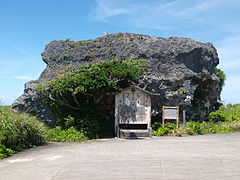1771 Great Yaeyama Tsunami
Ryūkyū Kingdom: Ryukyu Islands | |
| Tsunami | Yes |
|---|---|
| Casualties | 13,486 deaths[1] |
The 1771 Great Yaeyama Tsunami (also called 明和の大津波, the Great Tsunami of Meiwa) was caused by the Yaeyama Great Earthquake at about 8 A.M. on April 24, 1771, south-southeast of


Earthquake analysis
According to the Japanese government publication Rika-Nenpyō (理科年表) or Chronological Scientific Tables,[2] the epicenter was 40 km south-southeast of Ishigaki Island with a magnitude of 7.4. According to the Mamoru Nakamura Laboratory, University of the Ryukyus, the earthquake was due to the activity of the fault east of Ishigaki and it is estimated that the magnitude was 7.5.[3][4] Further simulation led to the activity of faults in the Ryukyu oceanic trench and the magnitude was 8.0. Also, there is a hypothesis that claims the magnitude was 8.5.[5][6] The depth was 6 kilometres (3.7 mi).[7] This trench lies between the Philippine Sea Plate and the Eurasian Plate. The disparity in the amount of recorded shaking (maximum 4 JMA) and the size of the tsunami has led to the interpretation of this event as a tsunami earthquake.[4]
Damage
Earthquake
It is considered that the earthquake registered an intensity of 4 (on the Japanese scale) in the Yaeyama Islands, and the damage by the earthquake itself was not as serious as the ensuing tsunami.
Tsunami
The dead and missing amounted to 12,000 people, and more than 2,000 houses were destroyed on
Following the tsunami, the damage it caused was such that it led to a famine that lasted for 80 years.[8]
Boulders

There are many huge boulders on the coasts of the Yaeyema and Miyako islands that are believed to have been deposited by tsunamis. There was a legend that an islet disappeared, but this has never been verified. This set of rocks are called the Ishigaki East Coast Tsunami Rocks.[8] Among them, Yasura-ufukane, Amatariya–Suuari and Taka-koru sishi have been dragged by the 1771 Meiwa tsunami.[9]
See also
- 1741 eruption of Oshima–Ōshima and the Kampo tsunami
- 1792 Unzen earthquake and tsunami
- List of earthquakes in Japan
- List of historical earthquakes
- List of tsunamis
Footnotes
- ^ a b National Geophysical Data Center. "Comments for the Significant Earthquake". Retrieved 22 July 2011.
- ^ "理科年表-オフィシャルサイト".
- ^ "1771年八重山地震津波(明和の大津波) (1771 Yaeyama Earthquake Tsunami (Meiwa Great Tsunami))" (in Japanese).
- ^ .
- .
- ^ 阿部勝征. "津波地震とは何か" [What is a tsunami earthquake]. 月刊地球 (in Japanese). 25 (5): 340.
- ^ "1771年明和津波(八重山地震津波)はマグニチュード8の海溝型巨大地震であった (The 1771 Meiwa Tsunami (Yaeyama Earthquake Tsunami) was a magnitude- 8 subduction earthquake)" (in Japanese).
- ^ a b c "The great tsunami of Meiwa" (PDF).
- ^ .
